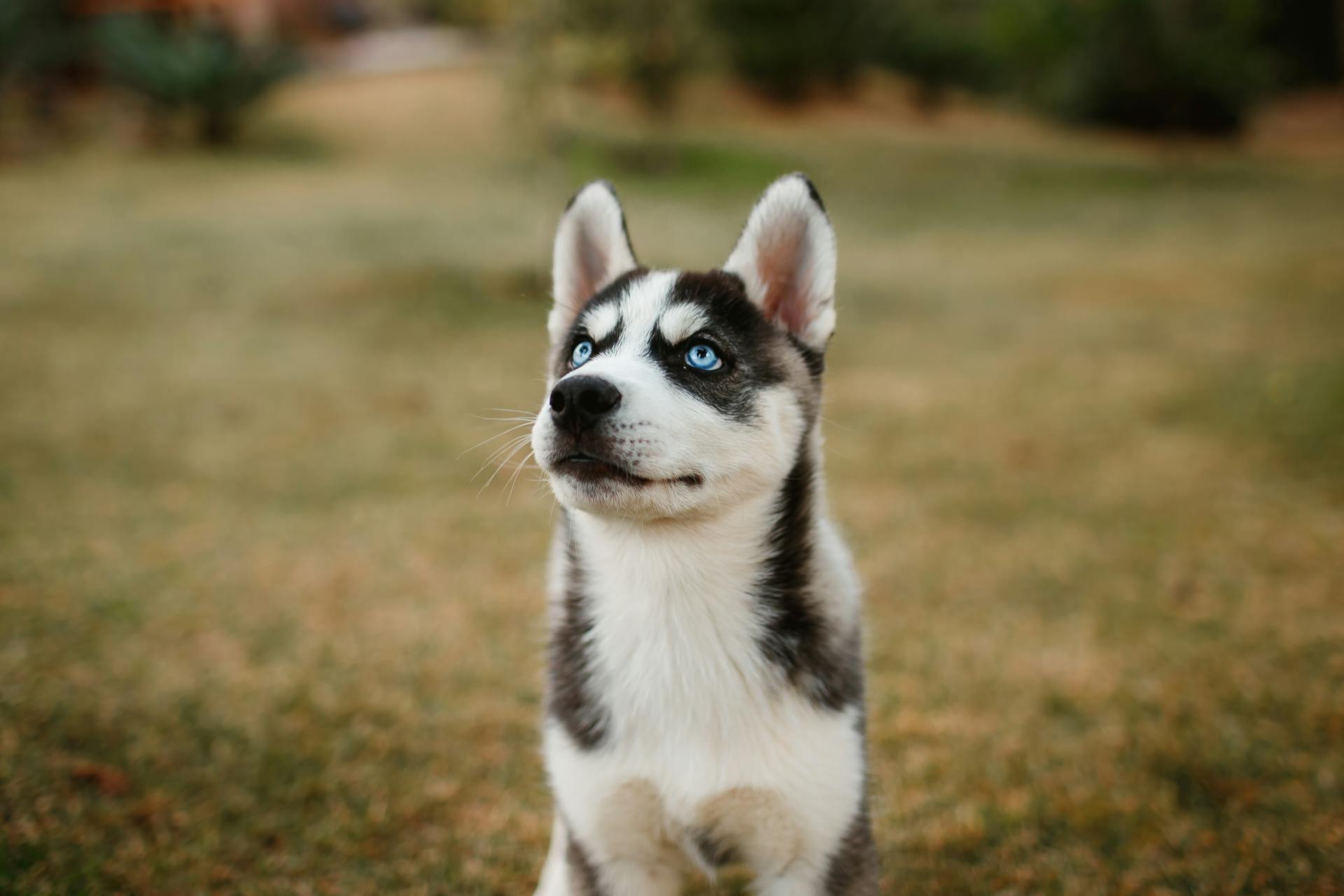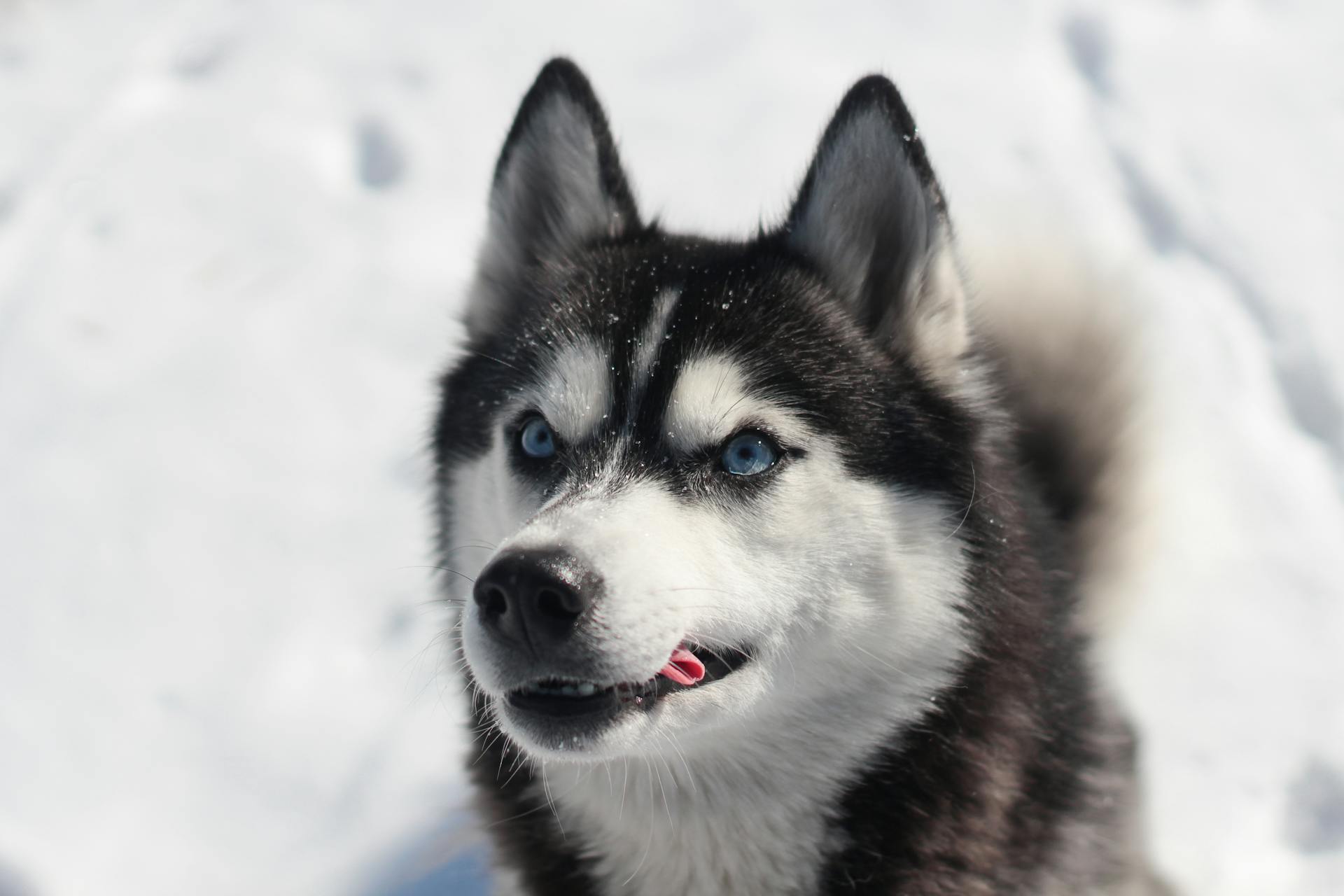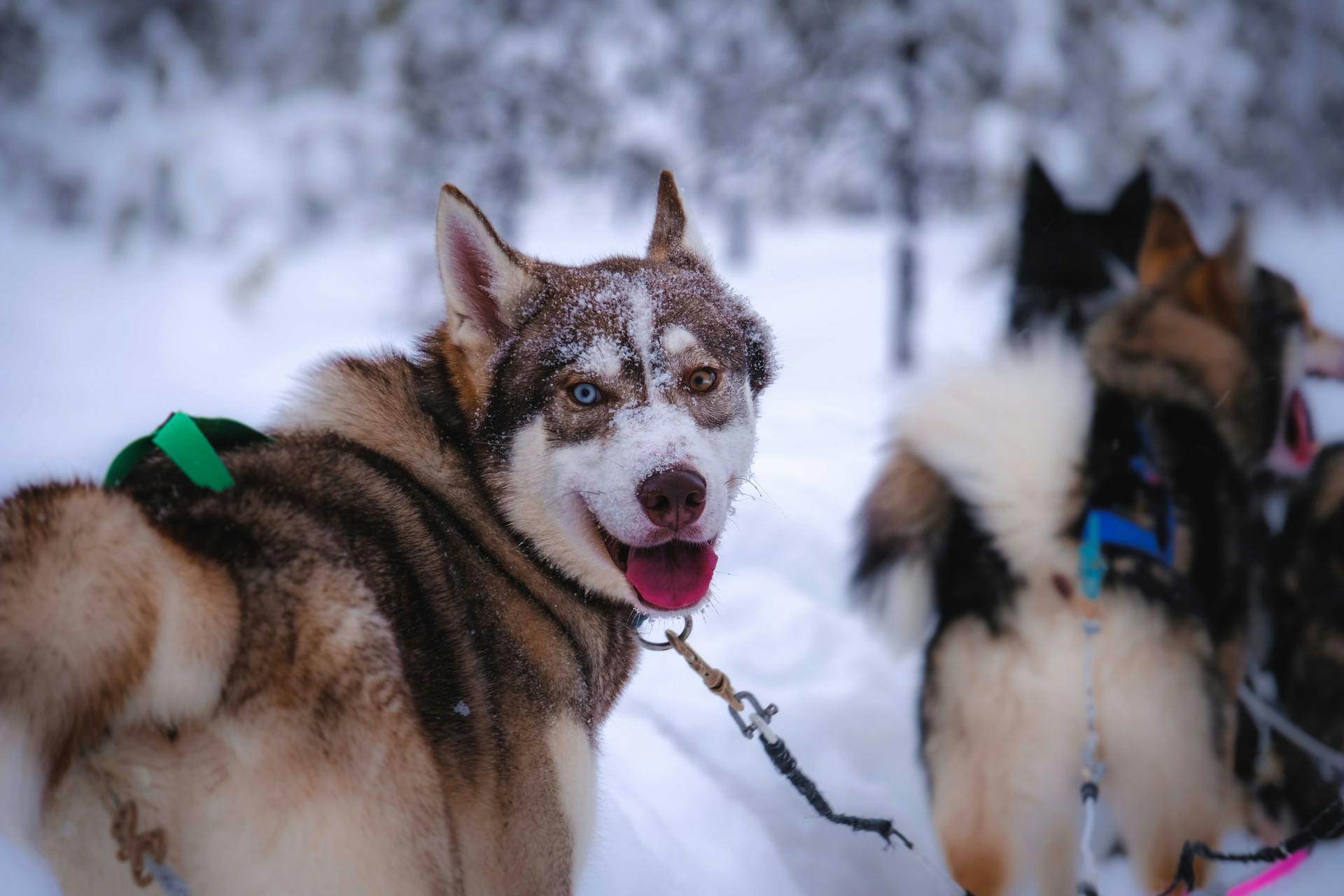
The Mini Husky Pomeranian Mix is a unique and adorable breed that makes a great companion for many families. This breed is a cross between a Siberian Husky and a Pomeranian, resulting in a small to medium-sized dog with a thick double coat.
To care for your Mini Husky Pomeranian Mix, it's essential to provide regular grooming to prevent matting and tangling of their fur. They require daily brushing to keep their coat clean and healthy.
Their high energy levels mean they need plenty of exercise to stay happy and healthy. A daily walk or playtime is a must, but be aware that they can be prone to obesity if overfed.
A balanced diet is crucial for this breed, with a mix of high-quality protein, healthy fats, and complex carbohydrates. Feeding them 2-3 times a day can help prevent overeating and maintain a healthy weight.
Size and Growth
A Teacup Pomsky can weigh as little as 3 pounds and be as small as 10 inches tall, but size can vary depending on lineage.
Full-grown Pomskies typically weigh around 20 pounds and reach 10-15 inches in height.
Some Pomskies can grow as big as a Husky, but most owners can expect them to be around 20-30 pounds.
These dogs tend to lose their "baby Husky" looks as they mature, so it's essential to consider their adult size when deciding to bring one home.
No one can guarantee the exact size of a full-grown Pomsky, but breeders can obtain Pomskies smaller than 10 pounds.
You might be surprised to see how big your Pomsky gets, so it's crucial to consider long-term responsibilities and space requirements.
If you're not prepared to provide regular exercise and attention, a Pomsky might find ways to escape or get into trouble, like digging in your yard.
Here's an interesting read: Full Grown Husky Collie Mix
Temperament and Personality
The mini husky Pomeranian mix is a unique and lovable breed, but it's essential to understand their temperament and personality before bringing one home. They're a sociable and affectionate breed that thrives on attention and cuddles.
Their high intelligence means they pick up commands easily and respond well to positive reinforcement training. This makes them a great choice for families with smaller children.
However, they can be prone to random bursts of energy and often, anxiety, so they require plenty of activity and companionship from their human family. A bored Pomsky can quickly turn into a fluffy ball of destruction.
As a vocal breed, they may inherit the husky's love of howling and the Pomeranian's love of yapping, so training is crucial to minimize barking and whining tendencies. You must train your dog's not to vocalize as much while they're still puppies.
Their extroverted outlook means they get along well with strangers and other animals too, making them perfect for families with multiple pets. However, they can accidentally hurt small children, so they're not ideal for households with very young kids.
Overall, the mini husky Pomeranian mix is a gentle, playful, and confident breed that requires plenty of attention, exercise, and training to thrive.
Grooming a Teacup Pomskies Coat
Grooming a Teacup Pomsky's coat is a daily task that requires a lot of attention. They have a thick, double-layered coat that sheds heavily twice a year.
Regular brushing is essential to prevent matting and loose hairs. A bristle brush is best for daily brushing, while a deshedding brush is perfect for tackling their undercoat during shedding seasons.
Daily brushing not only keeps their coat healthy but also stimulates blood flow. It's a great bonding session between you and your Teacup Pomsky, and it helps you keep an eye out for any fleas or ticks.
Most Teacup Pomskies require a bath every 4 to 6 weeks, but due to their fluffy coats, regular bathing is necessary. You can also use doggy wipes or waterless shampoo in between baths.
A good vacuum cleaner is a must-have for any Teacup Pomsky owner, as they shed almost all year round.
Here's a breakdown of their grooming needs:
- Daily brushing (3-5 times a week)
- Bathing (every 4-6 weeks)
- Nail care (regular)
- Ear cleaning (at least twice a month)
- Teeth cleaning (once a week)
By following this grooming routine, you can keep your Teacup Pomsky's coat healthy and beautiful, and reduce the amount of hair around your house.
Health and Diet
The mini husky Pomeranian mix is a relatively new breed, and as such, there isn't a wealth of information on its potential health concerns. However, since both parent breeds are generally healthy, it's unlikely that your mini husky Pomeranian mix will experience any significant health problems.
Potential health issues to watch out for include hip dysplasia, which can cause limping, dragging of the hind legs, or difficulty climbing, and collapsing trachea, which can result in a dry 'honking' cough or labored breathing. Allergies and skin problems are also possible, manifesting as rashes or constant scratching.
Your mini husky Pomeranian mix can live for 12 to 15 years with proper care, so it's essential to attend regular veterinarian checkups and keep up to date with all vaccines and recommended treatments.
Here are some potential health problems and their symptoms:
- Hip Dysplasia: Limping, dragging of their behind, or difficulty climbing
- Collapsing Trachea: Dry ‘honking’ cough or labored breathing
- Allergies and Skin Problems: Rashes or constant scratching
- Luxating Patellas: Skipping or hindlimb lameness
The Teacup Diet
Teacup Pomskies need a balanced diet at every age, with food containing plenty of protein, vitamins, minerals, and healthy fats. Fiber is also important.
In the first two to six months of life, Teacup Pomskies require two to three meals a day with occasional snacks in between, as their bodies experience the most growth and development.
After six months, you can reduce their meals to two per day. Adult Teacup Pomskies should eat ½-⅔ cups of food each day.
As a fairly small breed, the Pomsky requires far less food than its Husky parent. On average, a Pomsky requires around 2.5 cups of food per day, split into several small meals.
Keep in mind that this amount is just an average, and you should refer to the feeding guidelines for the specific food you're using to determine the best portion size for your Pomsky.
Curious to learn more? Check out: Pomsky Shiba Inu Husky Mix
Health and Conditions
As a responsible dog owner, it's essential to be aware of the potential health risks associated with your Pomsky. Thankfully, this mix breed tends to be relatively healthy, with both parents being quite healthy breeds.
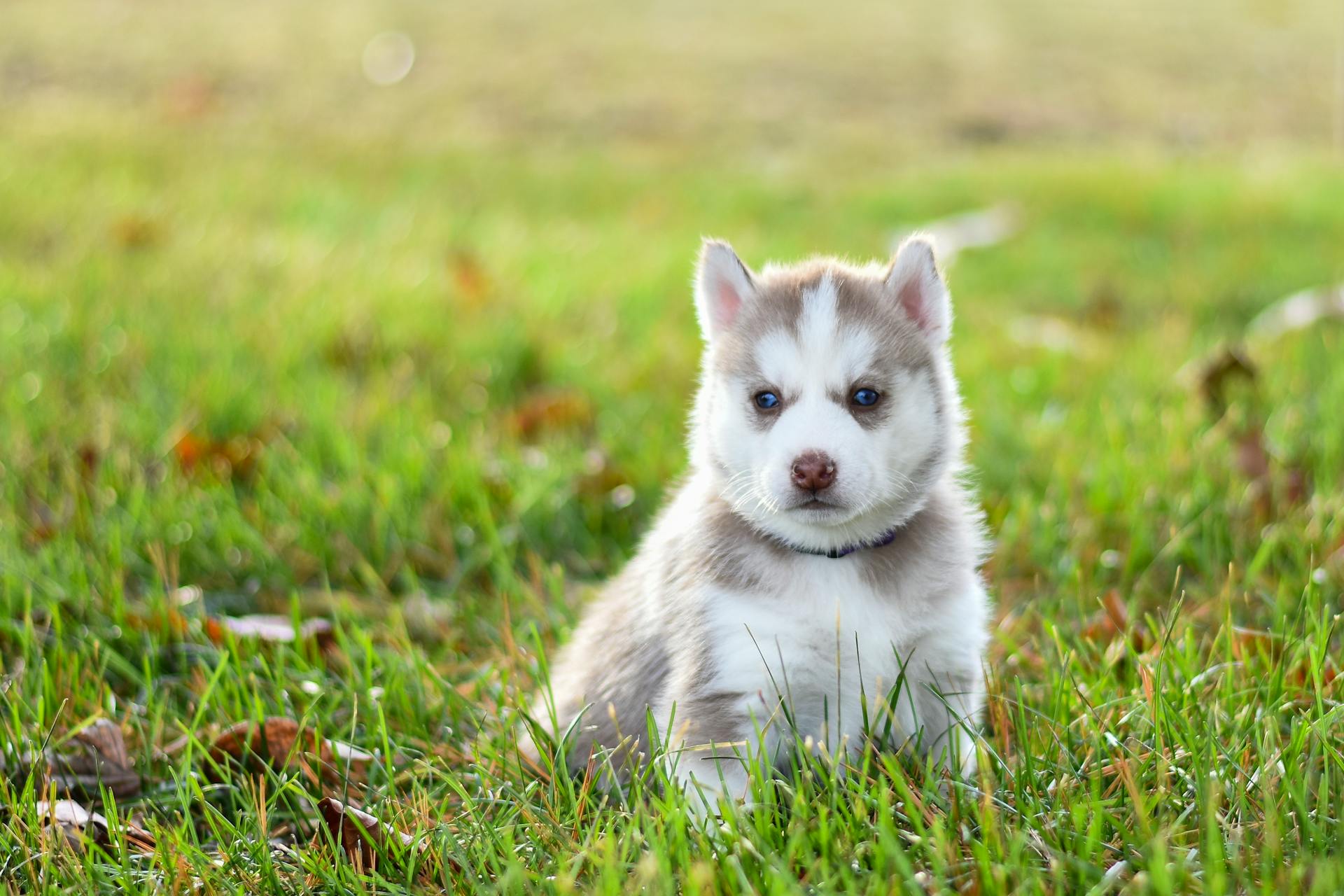
Pomskies can be prone to hip dysplasia, a condition that can cause limping, dragging of their behind, or difficulty climbing. Regular exercise and a healthy weight can help prevent this issue.
Allergies and skin problems are also common in Pomskies, with symptoms including rashes or constant scratching. Keeping your dog's coat clean and well-groomed can help alleviate these issues.
Luxating patellas, a condition that causes skipping or hindlimb lameness, can also affect Pomskies. Maintaining a healthy weight and providing regular exercise can help prevent this issue.
Here are some potential health problems to watch out for in your Pomsky:
- Hip Dysplasia: Limping, dragging of their behind, or difficulty climbing
- Collapsing Trachea: Dry 'honking' cough or labored breathing
- Allergies and Skin Problems: Rashes or constant scratching
- Luxating Patellas: Skipping or hindlimb lameness
With regular veterinarian checkups and proper care, Pomskies can live for 12 to 15 years. It's essential to stay on top of vaccinations and recommended treatments to keep your dog healthy.
Exercise and Living
Mini Husky Pomeranian Mixes need regular exercise and stimulation to prevent boredom and destructive behavior. They're deceptively active despite their size.
One hour of exercise daily is required to keep them happy and healthy. This can be in the form of agility sports like frisbee or dog agility courses.
Pomskies generally prefer unstructured playtime to traditional walks, but you shouldn't forego trips around the neighborhood altogether. They typically need to walk about 10 miles per week, spread out over several outings.
Their small size makes them prone to "bolting" at a moment's notice, so it's essential to use a secure leash and harness when walking them. This can help prevent accidents and keep them safe.
If you're unsure about how much exercise your Pomsky needs, start with about 45 minutes of moderate exercise each day and adjust as needed. This will help you find the right balance for your furry friend.
Owning and Caring
Owning a mini husky Pomeranian mix requires a good understanding of their unique needs. These dogs have double coats with long, silky hair that need daily brushing during the shedding seasons, which last about six months a year.
They also require regular exercise, with at least a 20-minute walk in the morning and a longer one in the afternoon, plus one or two play sessions during the day. This high energy level means they need plenty of physical and mental stimulation.
To manage their grooming and exercise needs, here's a quick rundown of what to expect:
- Grooming: daily brushing during shedding seasons, 3-5 times a week for the rest of the year
- Exercise: at least 20-minute morning walk, longer afternoon walk, and 1-2 play sessions per day
Owning a Dog
Owning a dog can be a challenging but incredibly rewarding experience. With the right care and attention, your furry friend can thrive and become a beloved member of your family.
First and foremost, it's essential to understand that every dog is unique and requires individualized care. Pomskies, in particular, have specific needs that set them apart from other breeds.
Daily brushing is a must for Pomskies, especially during shedding season, which lasts about six months of the year. This will help prevent matting and tangling of their beautiful coats.
Exercise is also crucial for Pomskies, who require at least a 20-minute walk in the morning and a longer one in the afternoon, plus one or two play sessions during the day. This will help keep them physically and mentally stimulated.
Feeding your Pomsky requires regular, healthy food in moderate quantities. They're not fussy, but it's essential to provide them with a balanced diet to maintain their overall health.
Here's a quick rundown of Pomskies' exercise needs:
As a responsible dog owner, it's also essential to consider the potential behavioral issues that can arise in Pomskies. They can develop Small Dog Syndrome or become overprotective and territorial, so it's crucial to train them properly and socialize them from an early age.
With patience, love, and proper care, your Pomsky can become a loving and loyal companion.
Cutting Down Expenses
Owning a Pomsky can be a costly endeavor, with prices ranging from $1,000 to $5,000 depending on the parents' pedigree. The average cost of the first year is around $2,889.
You'll need to budget for toys and accessories, which will set you back around $432 per year. Food costs around $435 per year, while preventative medication is around $389 per year.
Veterinary bills can be a significant expense, coming in at around $650 per year. To prepare for potential medical issues, consider investing in medical insurance, which can cost between $200 and $700 per year.
Here's a breakdown of the estimated annual costs:
4 Great Alternatives
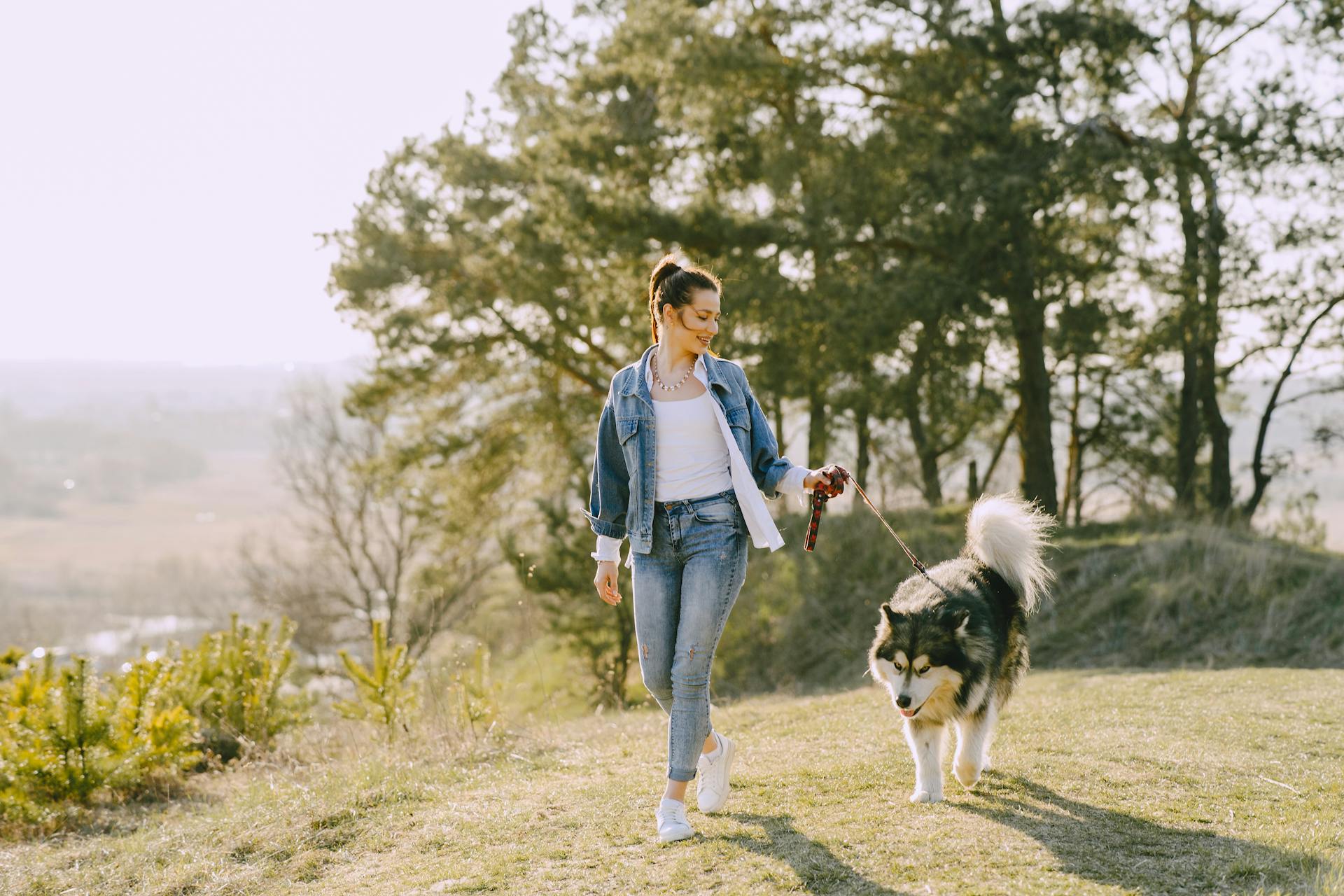
If you're considering owning a Pomsky but want to explore other options, here are four great alternatives to consider.
The Alaskan Klee Kai is a purebred dog that sheds less than the Siberian Husky, but they're even more active and sometimes require a lot of patience with training.
Finnish Lapphunds are cute purebred dogs that have mild temperaments and respond well to training, but they have high activity levels and shed more.
Keeshonds are similar to Pomskies when it comes to maintenance and exercise needs, but they shed more and grow a lot bigger.
German Spitz is a smaller and easier-to-maintain purebred dog that sheds less and is more suited to living in an apartment with no yard.
Here are some key characteristics of these breeds:
Breeding and Rescue
Breeding a mini husky Pomeranian mix requires some extra effort, as these two breeds can't be bred naturally due to their size difference. The mother is always a Siberian Husky and the father a Pomeranian, and artificial insemination is needed to make it possible.
Breeders often have to travel to find a reputable breeder, and some may even ship the pups to you. However, a reputable breeder will usually require you to meet them in person, which is a good sign that your pup has been well looked after.
Finding a mini husky Pomeranian mix at a rescue is rare, as owners are less likely to surrender them due to their high value.
Breeding
The Pomsky breed is created through artificial insemination, which is necessary due to the size difference between the Pomeranian and Siberian Husky parent breeds.
This process can be challenging and time-consuming, which is why many breeders don't endorse the creation of this breed.
The mother is always the Siberian Husky, and the father is always the Pomeranian.
Because of the unique breeding process, it's almost certain that you'll need to travel to find your Pomsky, and a reputable breeder will often require you to meet them in person.
Recommended read: Standard Poodle Husky Mix
This is a good sign that your pup has been well looked after, and it's not uncommon for breeders to ship the pups to you if you can't meet in person.
The size difference between the parent breeds can also result in a variation in the standard size of the Pomsky, meaning no two dogs will be alike, even from the same litter.
A fresh viewpoint: Husky Shepherd Mix Size
Rescues
Rescues can be a great way to find a Pomsky, but it's a bit of a long shot since owners are less likely to surrender them due to their high value.
You can check out resources like adoptapet.com to see if any Pomskies are available for adoption. However, availability will depend on the rescue.
Most owners will hold onto their Pomskies even if they're experiencing behavioral problems, making them harder to find at rescues.
Frequently Asked Questions
How big do mini Pomsky get?
Mini Pomskies typically weigh between 12-20 pounds and stand up to 14 inches tall at the shoulder.
How much does a Pomeranian husky mix cost?
A Pomsky's price ranges from $2000 to $7000, depending on size and quality. Prices vary from puppies to adults, with show-quality and miniature Pomskies being the most expensive.
Is Pomsky a good dog?
Pomskies can make great pets for the right family, but they may require extra attention and care due to their loyal and potentially skittish nature. They're best suited for households with older children or experienced dog owners.
Featured Images: pexels.com
